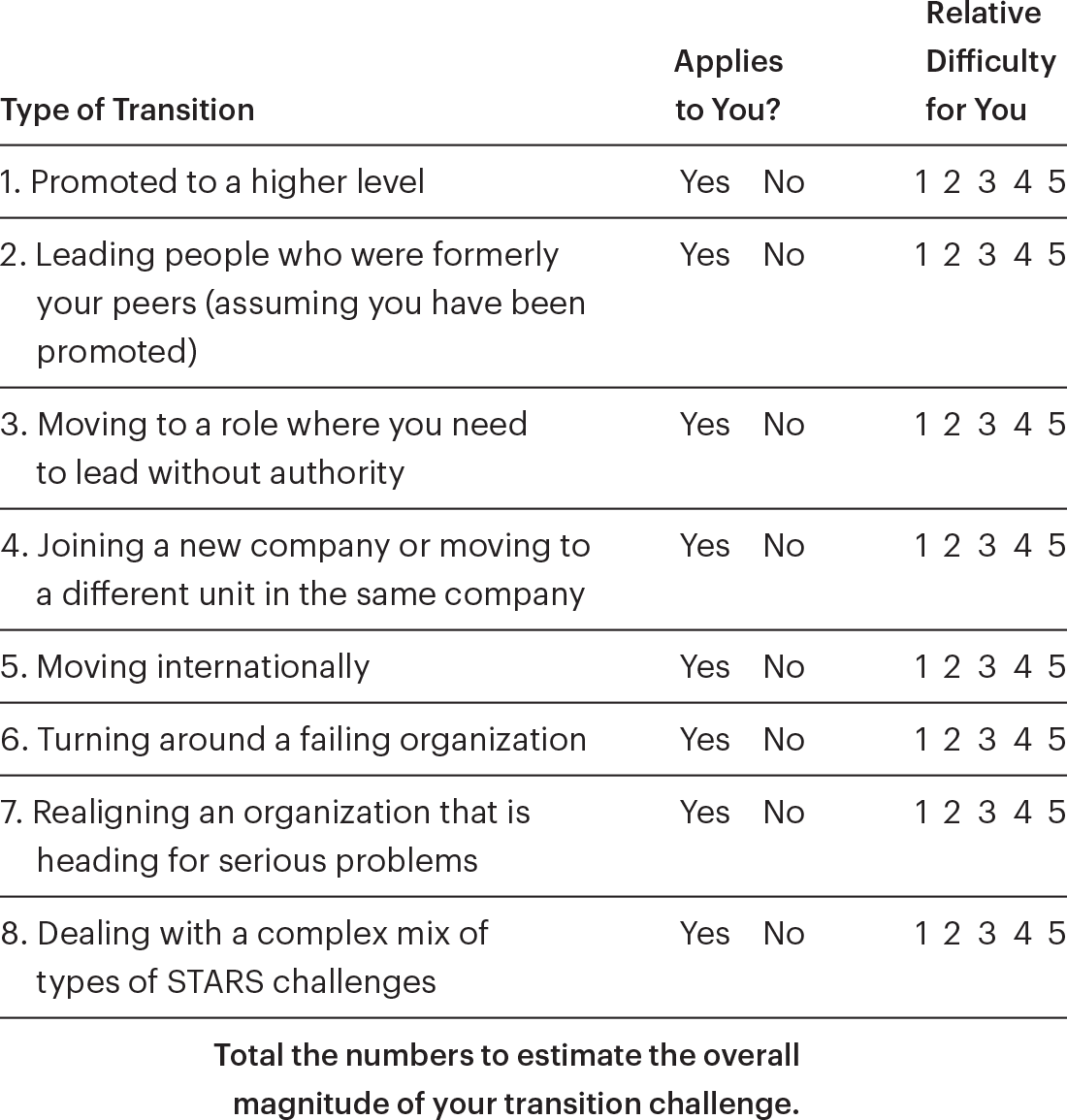 INTRODUCTION
INTRODUCTION
Master Your Next Move
Transitions into new roles are the most challenging times in the professional lives of leaders. That’s a bold statement, but it’s true and backed up by more than a decade of research and practice. If you are successful in rapidly scaling the learning curve, building key relationships, and getting early wins, your momentum will propel you through the rest of your time in your new role. But early missteps can create bad first impressions, leading to negative feedback loops in which you look increasingly unsuited for the job. Left unchecked, you could end up in a downward spiral it might be difficult or impossible to recover from.
I wrote The First 90 Days, the book for which Master Your Next Move is the essential companion and resource guide, because I’d seen too many leaders get into needless trouble early on in their new roles. They made common mistakes—not learning enough about their new organization’s culture and politics, coming in with “the answer,” trying to do too much too soon, not aligning expectations—and they paid the inevitable price in derailment or underperformance.
So I set out to create a framework and tools that could be applied by leaders in virtually any transition into a new role. In doing so, I looked for what’s common in transitions, not what’s different, and I distilled things down to an eight-element framework and supporting set of tools that leaders at all levels can apply to speed up their transitions, summarized in the box “The First 90 Days Framework.”
The Challenges of Different Types of Transitions
Since The First 90 Days was published, I’ve worked with thousands of leaders who have applied the concepts and tools in the book to accelerate their transitions. While thankful for the support, many also posed challenging questions, most of which revolved around how to apply the book’s basic principles in the diverse types of transition challenges they faced.
“I’ve been promoted from VP of marketing to country managing director, and I’m struggling to know what I need to focus on.”
“I’ve moved from an operating role to a regional HR position and feel like I’m wading in quicksand.”
“I’ve been transferred to a supply chain role in Indonesia and haven’t a clue how to operate in [this new] culture.”
Master Your Next Move is my answer to their questions. Where The First 90 Days is about common principles for making successful transitions, this book is about the unique challenges of different types of transitions and how to apply those principles in the specific situation you’re facing. The First 90 Days framework can be applied in every transition, but the way you apply it is entirely different when you have been promoted to a higher level than it is when you are joining a new organization or taking a role in a different country. If you fail to understand the unique demands of the specific transition you are experiencing, you can set yourself up for a derailment.
What are the most common types of transitions leaders face as they take on new roles? After much consideration, and based on my research and experience, I selected eight classic types of transitions. Each is the subject of a chapter in this book.
- The promotion challenge: Moving to a higher level and understanding what you need to do to be successful there, including issues of focus, delegation, developing leadership competencies, and demonstrating “presence.”
- The leading-former-peers challenge: An important variant of promotion in which you have been elevated to manage a team including your former peers, with the associated challenges of establishing authority and reengineering existing relationships.
- The corporate diplomacy challenge: Moving from a position of authority to one in which you need to be effective in influencing others and therefore need to map the influence landscape, identify powerful people and their agendas, and build supportive alliances.
- The onboarding challenge: Joining a new organization and grappling with the need to understand and adapt to the new culture, develop the right political “wiring,” and align expectations with your new boss, peers, and other key stakeholders.
- The international move challenge: Leading people in an unfamiliar culture while at the same time moving your family and creating a new support system.
- The turnaround challenge: Taking over an organization that is in deep trouble and figuring out how to save it from failure.
- The realignment challenge: Inheriting an organization that’s in denial about its need for change and creating a sense of urgency before simmering problems force it into a turnaround situation.
- The business portfolio challenge: Leading an organization in which different units are in different modes—start-up, turnaround, accelerated growth, realignment, and sustaining success—and figuring out where to focus your attention and how to build momentum.
This is by no means a definitive list of all the possible types of transitions you could experience over the course of your career. Absent are the challenges of succeeding in a newly created role, moving from one business function to another, and taking on a cross-functional role for the first time. Also missing are some specific challenges associated with organizational change, such as sustaining success, integrating an acquisition, or shutting down a failed operation.
In the end, however, I had to balance the competing demands of completeness and compactness. The eight types are a reasonably comprehensive list of the most challenging transitions you will make now and over the course of your career. They are nearly universal in today’s leadership careers; their ubiquity and timelessness means leaders who can deal with them effectively will be much more successful. In fact, if you can succeed in these eight types of transitions, you can deal with virtually any transition challenge!
How to Use This Book
Master Your Next Move was designed to be used in tandem with The First 90 Days. That book provides the general framework and tools for making successful transitions. This book will help you gain deep insight into how to apply the principles and tools laid out in The First 90 Days in the specific types of transitions you are facing. You will get detailed advice about how to succeed when you are moving to a higher level or leading former peers or joining a new organization or dealing with a new type of business situation.
If you are taking on a new role now, it’s likely that a number of the chapters will be immediately relevant. My research has shown that leaders taking new roles almost always experience two or more of these types of transitions at the same time. So start by identifying which of the types you are experiencing now and focus first on those chapters. The assessment in the box “Diagnosing Your Transition Challenges” will help you do that. However, sooner or later, as you progress through your career, you will probably want to read them all.
The first five chapters—on promotion, leading former peers, leading without authority, onboarding, and international moves—deal with common types of personal adaptive challenges. These are situations in which you, the leader taking on a new role, need to work on yourself to be successful. If you are experiencing a personal adaptive challenge, you need to ask: Given my history, mind-set, and capabilities, what are my most important development priorities? What do I need to do differently if I’ve been promoted, or joined a new company, or moved internationally, or some combination of these situations? What do I need to do more of and less of? What new competencies do I need to develop? What adjustments in my leadership style do I need to make? These five chapters not only provide detailed advice for meeting each type of personal adaptive challenge; they also provide you with tools you can apply in this specific type of situation and elsewhere.
The last three chapters of this book deal with distinct types of organizational change challenges. Here the key is to figure out how to adjust your approach to leading change to the type of business situation (or mix) you have inherited. In The First 90 Days, I developed a framework called the STARS model to help leaders taking new roles do this. STARS is an acronym for five common situations transitioning leaders may find themselves facing: start-up, turnaround, accelerated growth, realignment, and sustaining success. The STARS model outlines the characteristics and challenges of, respectively, launching a venture or project; getting an organization back on track; dealing with rapid expansion; reenergizing a previously strong organization that’s now facing serious problems; and sustaining the success of a high-performing organization and perhaps following in the footsteps of a highly regarded leader. The chapters provide specific strategies for leading change in three of the most common scenarios: turnaround, realignment, and dealing with a complex mix of STARS scenarios.
Finally, in the conclusion, I step back and explore the implications of focusing on types of transitions for businesses as a whole. Transitions into new roles go on all the time in most organizations. Cumulatively, their success or failure has a major impact on overall organizational performance. Given that independent research has shown that the right transition support can yield 50 percent reductions in the time required for leaders to reach optimal performance in their new roles, organizational systems for accelerating transitions at all levels are an essential element of enterprise risk management and a potential source of competitive advantage. So I look at how companies can best support these leaders, laying out some basic principles for creating enterprise-wide transition acceleration systems.
In summary, this book is about how leaders can survive and thrive when dealing with the classic types of transitions that virtually everyone faces on their journey to the top. The chapters that follow build on my work in The First 90 Days but delve much more deeply into the specific transition challenges you are facing now and will continue to face in the future. You will be given clear road maps—advice and tools—to excel in your next move . . . and in every move after that.

